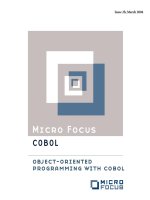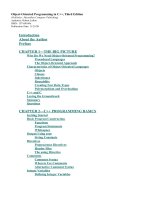Object oriented programming with C++ - Session 2 More on Classes potx
Bạn đang xem bản rút gọn của tài liệu. Xem và tải ngay bản đầy đủ của tài liệu tại đây (247.72 KB, 37 trang )
Object Oriented Programming with C++/ Session 2/ 1 of 37
More on Classes
Session 2
Object Oriented
Programming with C++/
Session 2/ 2 of 37
Session Objectives
Use the scope resolution operator
Use dynamic memory allocation with
•
New
•
Delete
Use pointers to objects
Define and use Constructors
Define and use Destructors
Define the "Const" keyword
Object Oriented
Programming with C++/
Session 2/ 3 of 37
Session Objectives (Contd.)
Define and use the "this" pointer
Describe how objects and functions are
arranged in memory
•
Static Data Members
•
Static member Functions
Describe type conversions using
•
Converting by assignment
•
Type casting
Object Oriented
Programming with C++/
Session 2/ 4 of 37
Scope resolution operator
Function can be defined outside the class
specifier using a scope resolution operator ::
(double colon symbol) with the function
definition. .
• General syntax:
return_type class_name
::member_functions(arg1, arg2,. . .,argn)
•
The type of member function arguments must exactly
match with the type declared in the class specifier.
Important for defining the member functions
outside the class declaration.
Object Oriented
Programming with C++/
Session 2/ 5 of 37
Scope resolution operator (Contd.)
The left-hand operator of :: must be the name of
the class.
Only the scope operator identifies the function as
a member of a particular class.
Is also used to refer to global variable names in
cases where a global variable and a local variable
share the same name.
•
The syntax used is: ::global_variable
More freedom in naming variables.
• If two variables have different purposes, their names
should reflect the difference.
Object Oriented
Programming with C++/
Session 2/ 6 of 37
Dynamic memory allocation
An object is created when its definition appears
in a program and it is destroyed when its name
goes out of scope or the program terminates.
Useful to create a new object that will exist only
as long as it is needed.
new creates such objects and the operator
delete can be used to destroy them later.
Objects allocated by new and delete are said
to be on the free store.
Object Oriented
Programming with C++/
Session 2/ 7 of 37
New
The new operator is used to create a memory
space for an object of a class
The general syntax of the new operator is:
data_type pointer_variable = new data_type;
For example,
int *p; //pointer to integer type
float *f; //pointer to a float type
p = new int;
//allocates memory for an integer
f = new float; //allocates memory for a float
If call to new is successful, it returns a pointer to
the space that is allocated.
Object Oriented
Programming with C++/
Session 2/ 8 of 37
New (Contd.)
Returns zero if the space is not available or if
some error is detected.
Same syntax for an object. For example,
Student *stu_ptr;
//pointer to an object of type Student
stu_ptr = new Student;
//points to new Student object
The new operator is similar to the malloc()
function used in C.
Object Oriented
Programming with C++/
Session 2/ 9 of 37
Delete
Object created by new exists until it is explicitly
destroyed by delete.
delete pointer_variable;
Example of new and delete.
int *ptr;
ptr = new int;
*ptr = 12;
cout << *ptr;
delete ptr;
•
Always a good practice to delete memory when you are through
with it.
•
Be careful that you do not use pointers to memory that has been
deleted.
Object Oriented
Programming with C++/
Session 2/ 10 of 37
Allocatng Arrays
Allocate blocks consisting of arrays of varying
length using a similar technique.
int *ptr;
ptr = new int[100];
delete [] ptr;
Any time you allocate an array of objects using
new, you must use [] in the delete statement.
Error to delete a variable that has been
malloc'ed and it is an error to free a variable
that was allocated with new.
Object Oriented
Programming with C++/
Session 2/ 11 of 37
Pointers to objects
Pointers can point to objects as well as to
simple data types.
Declaring a pointer to an object of a
particular class is the same as declaring a
pointer to a variable of any data type.
At the time we write the program we do not
know how many objects we want to create.
Object Oriented
Programming with C++/
Session 2/ 12 of 37
Pointers to objects (Contd.)
Use new to create objects while the
program is running.
date *today_ptr;
//pointer to an object of type date
today_ptr = new date;
//points to the new date object
Since today_ptr is a pointer to an object
use arrow operator (->).
today_ptr->getdate();
Object Oriented
Programming with C++/
Session 2/ 13 of 37
Constructors
A constructor is a special member function
for automatic initialisation of an object.
Has the same name as the class it belongs
to.
Can declare and define constructors within
the class, or declare them within the class
and define them outside just as any other
member functions.
Object Oriented
Programming with C++/
Session 2/ 14 of 37
Constructors (Contd.)
class username {
public:
username(); //constructor
};
username::username() { }
No return type is used for constructors.
Also invoked when local or temporary objects of a
class are created.
Several constructors provide several ways of
initialising a class object.
•
A default constructor is a constructor that does not
have any arguments.
Object Oriented
Programming with C++/
Session 2/ 15 of 37
Constructors (Contd.)
class date{
int month, day, year;
public:
date() //default constructor
{day=1; month=1; year=1999;}
date(int x) //only day is specified
{day=x; month=1; year=1999;}
date(int x, int y, int z) //day month year
{day=x; month=y; year=z;}
};
Object Oriented
Programming with C++/
Session 2/ 16 of 37
Constructors (Contd.)
As long as the constructors differ sufficiently in
their argument types the compiler can select the
correct one for each use, as shown in the
examples given below.
Each example calls a different constructor
depending on the value of the argument.
date now;
date today(4);
date all(23,3,1998);
Object Oriented
Programming with C++/
Session 2/ 17 of 37
Destructors
A destructor is a member function that is called
automatically when an object is destroyed.
• Cannot be directly called from the class. The compiler
itself generates a call to a destructor when an object
expires.
Same name as the class but with a tilde (~) before
the class name.
class username {
public:
~username(); //destructor
};
•
Destructors have no return type. They also take no
arguments.
Object Oriented
Programming with C++/
Session 2/ 18 of 37
De-allocate memory with delete
Most common use of destructors is to de-allocate
memory that was allocated for the object by the
constructor using the new operator.
class String{
private:
char *str;
public:
String(char *s){ //constructor
int length = strlen(s);
str = new char[length+1];
strcpy(str,s);
}
~String() {delete[] str;} //destructor
};
Object Oriented
Programming with C++/
Session 2/ 19 of 37
The Const keyword
A constant is an entity whose value does not
change during the execution of a program.
The keyword const can be added to the
declaration of an object to make that object a
constant rather than a variable.
A constant cannot be assigned to, so it must be
initialised.
const int num=100;
num=200; //error
num++; //error
Object Oriented
Programming with C++/
Session 2/ 20 of 37
Const with pointers
When we use const with a pointer, there are two objects
involved. One is the pointer itself and the other is object
pointed to.
Prefixing a declaration of a pointer with const makes the
object, but not the pointer, a constant. Example
int num =10;
const int *iptr = #
*iptr = 25; //error
num = 25; //valid, num is not constant
int xyz = 200;
iptr = &xyz; //iptr can point anywhere else
*iptr = 305; //error
Object Oriented
Programming with C++/
Session 2/ 21 of 37
Const with pointers (Contd.)
Also possible to declare a pointer itself as a
constant rather than the object pointed to. To do
this the operator *const is used.
Example
int a1 = 777;
//constant pointer to integer
int *const ptr = &a1;
*ptr = 66; //valid
int a2 = 45;
ptr = &a2; //error, ptr is a constant
Object Oriented
Programming with C++/
Session 2/ 22 of 37
Const with pointers (Contd.)
The const keyword can also be used in
parameter lists to specify the valid usage of a
parameter. This feature is particularly useful in
function arguments.
void func(const char *str)
{
str = "hello"; //valid
*str = 'A'; //error
}
Example
void func1(const int index)
{ index = 5;} //error
Object Oriented
Programming with C++/
Session 2/ 23 of 37
this pointer
Keyword this gives the address of the object,
which was used to invoke the member function.
Whenever a member function is called, the
compiler assigns the address of the object which
invoked the function, to the this pointer.
Can be used like any other pointer to an object.
Can be used to access the members of the object
it points to with the use of the arrow operator.
this->age = 5;
this->getdata();
Object Oriented
Programming with C++/
Session 2/ 24 of 37
Use of this
class Person{
private:
int age;
public:
void display();
};
void Person :: display()
{ this->age = 25; // same as age=25
cout<<this->age; // same as cout<<age
}
void main()
{ Person Jack;
Jack.display();
}
Practical use for this is in returning values from member functions.
Object Oriented
Programming with C++/
Session 2/ 25 of 37
Objects and functions in memory
Each object has its own copy of the data
members of the class.
All the objects in a given class use the
same member functions. The member
functions are created and placed in
memory only once - when they are defined
in the class specifier.
Data is therefore placed in memory when
each object is defined, so there is a set for
each object.









